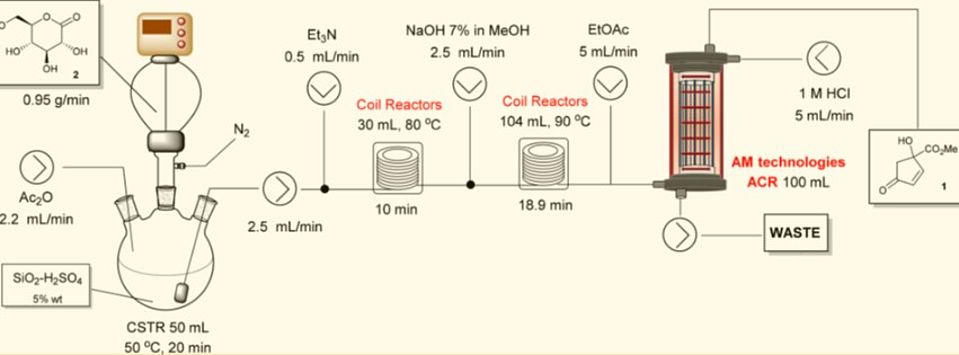The Role of the LAMBDA DOSER in an Automated Reactor Setup for the Continuous Flow Synthesis of Cyclopentenone Building Blocks
Continuous flow chemistry has become an increasingly popular approach in chemical synthesis due to its efficiency, scalability, and control over reaction conditions. However, to perform the synthesis in an automated setup can be challenging. In a joint study by Novartis Pharma AG, Switzerland, and the University of Durham, UK addressed this issue during the flow synthesis of a versatile cyclopentenone building block by using the LAMBDA DOSER for controlled solid dosing.

Reference: Sustainable Flow Synthesis of a Versatile Cyclopentenone Building Block, Marcus Baumann, Ian R. Baxendale, Paolo Filipponi, and Te Hu,Organic Process Research & Development 2017 21 (12), 2052-2059,DOI: 10.1021/acs.oprd.7b00328
Handling solid reagents in flow processes presents a significant challenge, as the solid must be fed into the reactor in a precise and controlled manner. In developing a continuous process to synthesize functional cyclopentenone, the team aimed to convert D-glucono-1,5-lactone into a cyclopentenone derivative. However, the poor solubility of the starting material in acetic anhydride (Ac2O) created difficulties in ensuring smooth and consistent integration into the flow system.
LAMBDA DOSER: Facilitating Solid Reactant Handling
To address the issue of solid reagent dosing, the team utilized the LAMBDA POWDER DOSER, a powder dosing system that enabled the controlled and continuous introduction of D-glucono-1,5-lactone into the reactor. This provided consistent delivery of solid material, essential for maintaining stable reaction conditions. The DOSER's settings allowed fine control over the amount of solid fed into the reactor, ensuring precise stoichiometry and minimizing any disruptions to the process.
By generating a calibration curve specific to the material being dosed, the researchers were able to align the DOSER settings with the required quantities of the solid reagent. This enabled the system to operate continuously without the need for manual intervention or adjustments, which is particularly advantageous in flow chemistry setups that require long, uninterrupted runs.

Fig 2: Calibration curve illustrating the material weight delivered over a 10-minute period at different dosing rates. (Graph credit: DOI: 10.1021/acs.oprd.7b00328; Org. Process Res. Dev. 2017, 21, 2052−2059)
Integration of Powder Feeder into the Flow Process
The LAMBDA DOSER was integrated with a continuous stirred tank reactor (CSTR), where the solid D-glucono-1,5-lactone was mixed with acetic anhydride and a catalyst. This reaction led to the formation of an intermediate, peracetylated gluconolactone which was processed further downstream to produce Cyclopentenone.

Fig 3: Showing the Integration of the LAMBDA DOSER into the two continuous stirred tank reactor (CSTRs) (Image Credit: DOI: 10.1021/acs.oprd.7b00328; Org. Process Res. Dev. 2017, 21, 2052−2059)
Incorporating the DOSER into the flow system helped overcome a key limitation: the poor solubility of the solid reagent. By enabling controlled reactant dosing, the team could successfully scale up the reaction and operate it continuously, achieving a throughput of 200 grams per hour of peracetylated gluconolactone intermediary compound. Achieving a high yield of intermediary compound, with precise control is essential for ensuring the efficiency and scalability of the entire flow synthesis. Moreover, this intermediate allows for a continuous process, minimizing the need for complex purification steps before moving on to the next stage.
After the production of peracetylated gluconolactone, it was transformed into pyranone (compound 7) via base-catalyzed elimination, followed by a base-mediated rearrangement using sodium hydroxide in methanol to yield the desired cyclopentenone. The final product was purified using an in-line aqueous extraction method, which removed impurities and excess reagents.

Fig 4: Overview of Cyclopentenone synthesis process and set up (Image Credit: DOI: 10.1021/acs.oprd.7b00328; Org. Process Res. Dev. 2017, 21, 2052−2059)
Conclusion
The integration of the LAMBDA DOSER into this continuous flow system highlights the importance of reliable solid dosing in flow chemistry. In this application, it allowed the researcher to overcome challenges associated with solid reagent handling, ensuring a stable, scalable, and efficient synthesis process. While solid dosing in flow chemistry can be a complex task, tools like the DOSER provide a practical solution for powder addition in a automatic and controlled manner these processes.
The use of the LAMBDA DOSER contributed to the success of the continuous flow process in several ways:
- Scalability: The DOSER made it possible to feed solid reagents continuously, which is crucial when scaling up flow processes that involve poorly soluble materials.
- Improved Process Control: Precise control over solid feeding ensured that the reaction proceeded smoothly, with minimal risk of deviations in stoichiometry or reaction rate.
- Continuous Operation: By enabling uninterrupted solid dosing, the DOSER helped maintain a steady flow throughout the process, avoiding the need for manual intervention.
For further details on the LAMBDA powder feeder DOSER and HI-DOSER, visit www.lambda-instruments.com/powder-doser/. For inquiries or quotations regarding the DOSER/HI-DOSER powder feeder, please reach out to us at sales@lambda-instruments.com